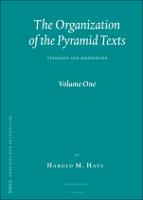The Organization of the Pyramid Texts (2 vol. set): Typology and Disposition
Author(s)
Hays, Harold M.
Collection
OAPEN-NLLanguage
EnglishAbstract
The ancient Egyptian Pyramid Texts form the oldest sizable body of religious texts in the world. Discovered in the late nineteenth century, they had been inscribed on the interior stone walls of the pyramid tombs of third-millennium kings and queens. From their content it is clear that they were concerned with the afterlife state of the tomb owner, but the historical meaning of their emergence has been poorly understood. This book weds traditional philological approaches to linguistic anthropology in order to associate them with two spheres of human action: mortuary cult and personal preparation for the afterlife. Monumentalized as hieroglyphs in the tomb, their function was now one step removed from the human events that had motivated their original production.
Keywords
history of religions; ancient egyptian religion; ritual studies; speech act theory; redaction criticism; quantitative analysis; performance theory; linguistic anthropology; religious studies; egyptologyDOI
10.26530/OAPEN_421591ISBN
9789004227491OCN
1030815290Publisher
BrillPublisher website
https://brill.com/Publication date and place
Leiden - Boston, 2012Series
Probleme der Ägyptologie, 31Classification
Egypt
BCE period – Protohistory
Archaeology by period / region
Ancient Egypt


 Download
Download Web Shop
Web Shop